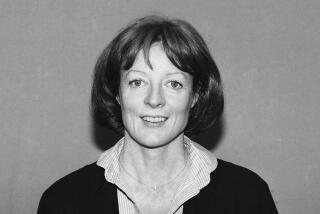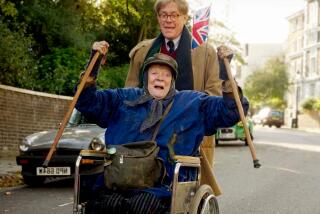Stanwyck a Unique Spirit Among Her Peers
- Share via
The founding fathers of the movie industry, and some of their heirs apparent to this very day, have preferred to think of women as decorative and reactive, cheering on the men who went off and did whatever valiant things needed doing.
Yet from Mary Pickford forward there have been women--never really that many, if you stop to count--who did not accommodate well to the passive voice and whose independent spirit earned them a popularity and a power that often gave the moguls fits but was irresistible.
Bette Davis seemed to spend much of her career jousting noisily with Jack Warner (and anyone else who sought to run her life for her). Rosalind Russell both portrayed and personified the self-starting, self-sustaining woman, delighted with the company of men, it might be, but on a sort of Dutch-treat basis in terms of careers and all else. Katharine Hepburn, Joan Crawford, Gloria Swanson, Olivia de Havilland (fighting her quieter wars with the studio system) spring to mind.
And so, most particularly, does Barbara Stanwyck, who died on Saturday at 82 after an astonishing six-decade career that ran from the chorus lines of Broadway to an early silent film, to being the best-paid actress in Hollywood in the early ‘40s, to a renewed career in television on a scale that only Lucille Ball and a handful of other film stars have managed.
If a fiercely independent cast of mind linked the women who rose to the heights of the star system, each of them was unique, distinct from each of the others. Two New Englanders could not have worn such different hauteurs as Bette Davis and Katharine Hepburn, for example, and two up-from-the-chorus dancers could not finally have had such unalike screen personas as Joan Crawford and Barbara Stanwyck: Crawford with a steely and regal arrogance when it was required, Stanwyck with the always lurking possibilities of being kittenish, naughty and quite wicked in a wide range of situations, as well as powerful and commanding as need be.
Stanwyck was too special, too identifiable, to qualify as Everywoman, and yet she never lost the most valuable gifts of her origins as Ruby Stevens in Brooklyn. Her resilience never overshadowed the sense that she was vulnerable; she was at home in the working class, the lower middle class, the middle class and that undefined terrain where people live and work who have escaped their beginnings. Better than many a sexpot starlet, she could convey a smoldering sexuality that was the more potent because it appeared to arise deep in her soul rather than from a sequence of thrusting and practiced postures.
The envy of the film stars is that they leave a tangible legacy as well as memories. Tomorrow’s film enthusiasts will discover in “Double Indemnity” and “Sorry, Wrong Number” just what a sensational dramatic actress she had learned to be, and her tour de force hysterics in “Sorry, Wrong Number” are chilling to remember.
A glimpse of “Ball of Fire” will introduce the comedienne who understood that laughter emerges from character as well as circumstances (and is aided wonderfully when you have a script by Charles Brackett and Billy Wilder). It is an irony of timing that “Stella” will shortly be in release, with Bette Midler in the role that Stanwyck created in “Stella Dallas” more than half a century ago, tearing hearts to shreds in the ultimate tear jerker as the unwed mother watching in the rain as her beautiful daughter marries into high society.
In the Frank Capra-Robert Riskin “Meet John Doe” with Gary Cooper, the warm and compassionate but still effective Barbara Stanwyck, making things happen, is on view. In “Annie Oakley,” there is to be seen the Stanwyck who could bring life and depth to a delightful historic eccentric.
That invaluable enshriner of film history, the late Leslie Halliwell, found a pair of Stanwyck quotes that hint of a whole biography. “I want to go on until they have to shoot me,” Stanwyck said. It was the kind of drive that possessed Bette Davis as well.
Barbara Stanwyck also said, “Put me in the last 15 minutes of a picture and I don’t care what happened before. I don’t even care if I was in the rest of the damned thing--I’ll take it in those last 15 minutes.”
It was the total professional talking. Gloria Swanson in “Sunset Boulevard” says: “We had faces then.” The pro that Stanwyck was might well have added that faces were never quite enough; to make it big, they had personalities that were eloquent, even in silent days.
Stanwyck and her few contemporaries brought the liberated woman and the raised consciousness to the screen even before the society had defined the terms (and before the bosses were quite ready for it). So doing, she and other stars not only entertained the society but may well have helped to prepare it for change.
More to Read
Only good movies
Get the Indie Focus newsletter, Mark Olsen's weekly guide to the world of cinema.
You may occasionally receive promotional content from the Los Angeles Times.









